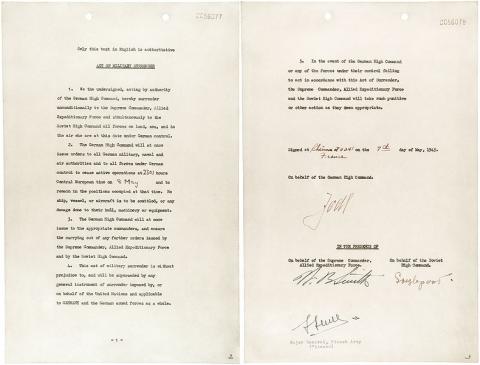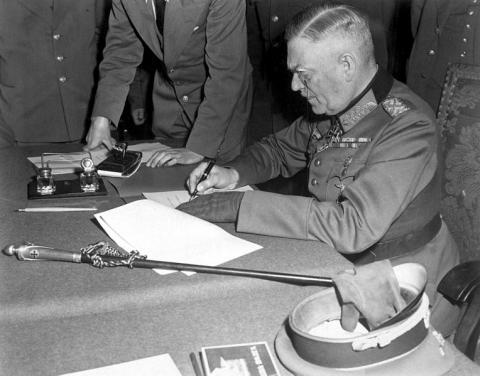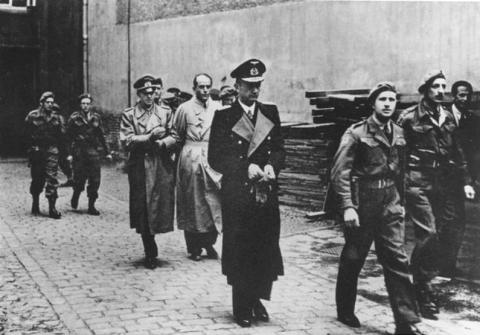May 8th German Capitulation Day - how legal is it?

This instrument of surrender was signed on May 7, 1945, at Gen. Dwight D. Eisenhower's headquarters in Rheims by Gen. Alfred Jodl, Chief of Staff of the German Army. At the same time, he signed three other surrender documents, one each for Great Britain, Russia, and France. Signatories: On behalf of the German High Command. JODL. IN THE PRESENCE OF: On behalf of the Supreme Commander, Allied Expeditionary Force. W. B. SMITH On behalf of the Soviet High Command. SOUSLOPAROV. Witnessed by F SEVEZ Major General, French Army. For an enlarged version, go here.
On May 7, 1945 the German Instrument of Surrender was signed in Rheims, France by representatives of the Oberkommando der Wehrmacht (OKW) and the Allied Expeditionary Force [US and UK] together with the Soviet High Command. Those signing were Alfred Jodl of the OKW, Walter Bedell Smith of the Western Allies, and Ivan Sousloparov of the Soviet Union.
On May 8, a second signing took place in Berlin by representatives of the three armed services of the OKW [Keitel, Stumpff and Friedeberg] and the Allied Expeditionary Force together with the Supreme High Command of the Red Army. French and US representatives signed as witnesses.
While it was in three languages, the document states that only the English version was considered authoritative.
Tag der Kapitulation in Germany is known in the West as VE Day (Victory in Europe).
* * *
The preparations of the text of the instrument of surrender began in January 1944 by US, Soviet and British representatives - called the European Advisory Commission, or EAC. They proposed that the capitulation of Germany should be recorded in a single document of unconditional surrender.
It was suggested that the instrument of surrender be signed by representatives of the German High Command to prevent the repetition of the "stab-in-the-back" belief widespread in Germany following defeat in the First World War. At that time, the act of surrender in November 1918 was signed by representatives of the German government only, allowing it to be claimed that the High Command was not responsible for that defeat. The Allies did not want a repeat of returning veterans arriving home believing they had not been vanquished.
* * *
The first Instrument of Surrender was signed at Rheims, at 02:41 Central European Time (CET) on 7 May 1945.
However … US diplomat Robert Murphy claims that EAC approved surrender documents were not signed on May 7 because an exhausted General Smith had thought that EAC had never approved a surrender agreement. He had filed away in his personal top-secret cabinet the folder containing the EAC text. The surrender documents of May 7 had been prepared on "miscellaneous reference material," whatever that means. Although the documents had been certified by General Sousloparov as the Soviet liaison officer, Moscow quickly protested that the surrender terms were not the EAC agreement which had been endorsed by the Soviets.
The May 7th document was signed by Generaloberst Alfred Jodl, on behalf of the Oberkommando der Wehrmacht (English: "Supreme Command of the Armed Forces") and as the representative for the new Reich President, Grand Admiral Karl Dönitz. But Dönitz himself never signed.
Shortly after the surrender had been signed, the Soviet Command announced that the Soviet representative in Rheims, General Sousloparov, had no authority to sign this document. In addition, it had been found that the document signed in Rheims was different from the draft prepared earlier, which had been approved by the Big Three.
A part of the Wehrmacht refused to lay down their arms and continued to fight in Czechoslovakia. A German radio broadcast stated that the Germans had made peace with the Western Allies, but not with the Soviets. This was actually the intention of Dönitz when he sent Jodl to sign at Rheims. Germans wanted to continue to fight in the East as long as German civilians and troops were still retreating to the West, out of Soviet controlled areas. By surrendering then, all troops had to lay down their arms and be captured by the Soviets. This was a tactic by Dönitz to save German lives.(Although it turned out that being in the captivity of the Americans did not save one's life at all.)
The Soviets would have none of it, though, as they understood exactly what was happening.
The Soviet side insisted that the act of surrender signed in Rheims should be considered "a preliminary protocol of surrender," so the Allies agreed that another surrender ceremony should take place in Berlin shortly before midnight on 8 May at the seat of the Soviet Military Administration in Berlin-Karlshorst.

Marshall Zhukov, Air Chief Marshall Tedder (UK), US General Carl Spaatz (as witness), French General Jean de Tassigny (as witness) … signed along with Keitel (pictured right, signing), Friedeberg and Stumpff. Wilhelm Keitel was Chief of the General Staff of the Armed Forces, representing the Army. Hans-Georg von Friedeberg was Commander-in-Chief of the Kriegsmarine and Hans-Juergen Stumpff represented the Luftwaffe.
Thus, while Jodl was said to sign as the representative of Reich President Karl Dönitz, that document was not considered the correct one, according to the Soviet Command, and agreed to by the U.S. and UK, so it can be said that the Reich government never surrendered. Only the German Armed Forces surrendered to the Allies.
* * *
The surviving Reich government, headed by Grand Admiral Karl Dönitz as Reich president, was known as the Flensburg Government because it was located in the city of Flensburg in Northern Germany. It's leaders were arrested on May 23, 1945 in a grossly dishonorable (and probably illegal) way, by way of subterfuge, after being summoned to a meeting with SHEAF representatives on the passenger ship Patria. The decision to do this was made on May 19 in a meeting between SHEAF and the Soviet High Command. Thus the Allied victors took control of the Reich by force, with no agreement by the representatives of the Reich or its people.

Grand Admiral Karl Donitz, followed by Gen. Alfred Jodl and Dr. Albert Speer after their surprise arrest by the Allied Supreme Headquarters Expeditionary Force, 23 May 1945.
Please visit the new website German Victims
Category
World War II- 1473 reads









